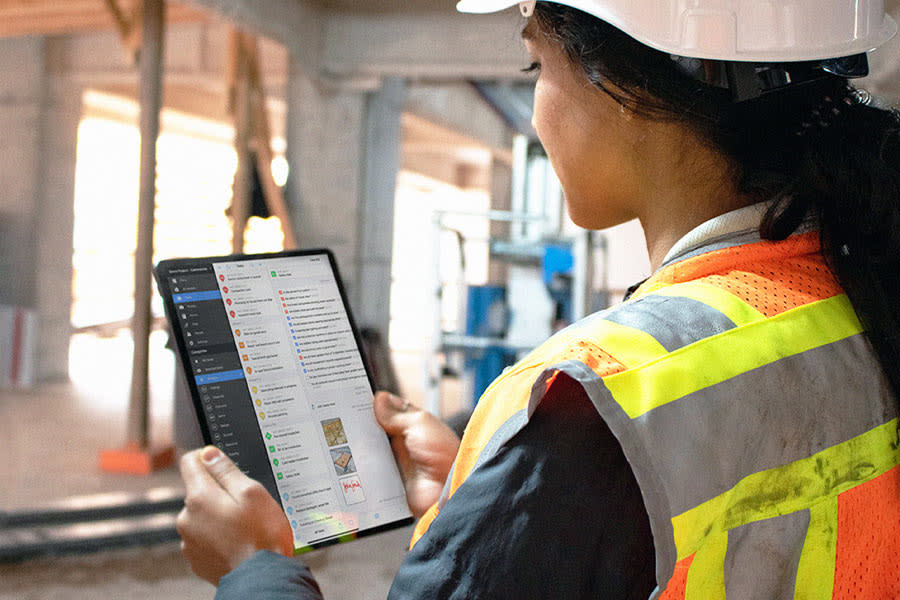How can data analytics improve decision-making in construction management?

Construction management has undergone a deep change as technology advances. While industry leaders once relied on personal experience and intuition, data now plays a larger role in guiding project completion from the drawing board through the finish. Data analytics refers to the process of collecting, analyzing, and interpreting data to guide decision-making and improve efficiency and outcomes.
Crews now have numerous avenues for amassing data, from site drones to the IoT. When used properly, these tech tools can do everything from predicting maintenance needs to improving site safety. Knowing what’s possible lets leadership teams employ these advances to their best advantage to get an edge on the competition. Here are seven ways data analytics can improve decision-making in construction management.
Four types of data analytics
First, you should understand the following four types of data analytics as a construction leader:
- Descriptive analytics: Crews use descriptive analytics to describe the sequence of events that led to the structural instability. For example, if a wall collapses, it answers the question, “What happened?”
- Diagnostic analytics: This addresses why something happened. In the above wall example, teams could use data to evaluate whether the underlying issue was damaged lumber, faulty fasteners or incorrect assembly.
- Predictive analytics: Using undamaged boards and correct assembly means a wall can withstand X pounds of pressure before collapse. Predictive analytics outlines when that could potentially happen.
- Prescriptive analytics: Predictive analytics describes what to do next. For example, if a wall is likely to collapse under X amount of pressure, how can crews reinforce it to withstand the load?
Next, examine how these types of data analytics specifically aid construction management.
1. Predictive analytics
Predictive analytics utilize historical data from your team or the experience of other firms. It can help crews:
- Accurately estimate job costs
- Devise a timeline and schedule
- Allocate resources
They often play a pivotal role in project planning, with obvious value in compiling estimates and making bids. Additionally, they can forecast aspects of a job crew chiefs might overlook if they have only a ground-level view of operations.
For example, technology can predict the potential adverse effects of a construction project on nearby waterways and whether they will trigger the need for additional permits near conservation areas. Knowing this from the drawing board starts the process, preventing future delays that can cost time and materials.
2. Resource allocation and optimization
Things change quickly on construction sites, so data analytics helps crews make the most efficient use of available equipment and personnel to minimize downtime and reduce waste. For example, real-time tracking alerts supervisors to delays on one portion of a construction site so they can send otherwise idle bulldozers and backhoes to an area awaiting their arrival.
Using data analytics to allocate resources appropriately matters for more than a crew’s bottom line — it also protects the planet. Currently, the construction industry accounts for 30% of all waste generated, greatly contributing to climate change. The same shifts that save you money also benefit Earth.
3. Quality control and risk management
How do you know when quality control issues arise? Historically, crews relied on reports from unsatisfied customers, which invariably led to conflicts. However, data analytics helps you analyze quality control data from inspections, testing results and defect reports in real time to identify and rectify patterns more quickly.
For example, using AI to analyze data can reveal the underlying cause behind a recurring defect that requires finishing correction. Identifying the reason for the deficiency and correcting it at the source prevents costly and time-consuming redoing of work.
4. Supply chain optimization
Part of construction management entails getting the materials you need to the job site on time. Having plumbing subcontractors stand around waiting for a pipe delivery wastes time when they could be handling other projects. While factors such as soaring gas prices due to supply chain issues or international conflicts affect all suppliers, data analytics can determine which does the best job for the lowest price regardless of external pressures.
Data analytics lets you keep better track of existing inventory and predict when to order more. It can even facilitate contract negotiations, providing data to back up mileage reimbursements and determining the best routes for goods to reach your site.
5. Performance monitoring and benchmarking
How well is that new piece of equipment performing? Data analytics lets you see how a new forklift pays for itself over time and eventually results in greater profits. It also compares your usage to industry benchmarks, letting you know if you’re making the best use of your investment. If not, where can you improve?
You can also use data analytics to track employee performance against key performance indicators, rewarding the best workers for a job well done. Encouraging those who exceed preset standards with bonuses and raises improves overall morale and productivity, encouraging others to excel.
6. Safety and risk analysis
Construction is a dangerous career, lagging behind only the transportation and materials-handling sectors in overall hazardousness. Reducing these accidents spares families immeasurable heartbreak, and avoids a considerable amount in lost labor and legal fees.
Data analysis informs leaders of why accidents occur, which is crucial when establishing liability. It also empowers them to make changes to prevent similar incidents in the future, maybe even stopping trouble in real time. Devices such as drones can monitor sites for hazards, alerting crews to dangers so they can evacuate humans from the scene.
7. Cost estimation and budgeting
How do you create estimates? Many leaders in the construction industry pull data from past jobs, request bids from subcontractors and study financial forecasts to determine the price of materials over the coming months. Even the best and brightest make mistakes that can prove costly. However, the right data analytic technology uses AI integration to do most of the work for you, combining information from various sources into comprehensive reports to guide decision-making.
The buck ultimately stops with you, so budgeting accurately ensures everyone gets paid on time and the job is completed to standard. Tying up time and resources with courtroom disputes and unnecessary liens is something no general or subcontractor wants, so use today’s tech to compile a meaningful project budget that covers every base.
Improve construction management decision-making with data analytics
Data analytics utilize technology to scour the mountains of information available today to help construction leaders make wiser decisions. It assists in every stage of projects, from planning through completion.
Using technology and data analytics improves site safety, eases supply chain woes, improves budgeting and estimating, and effectively allocates resources. Using them to guide decisions leads to better job site performance, fewer headaches and a bigger bottom line.

 Rose Morrison •
Rose Morrison • 


















